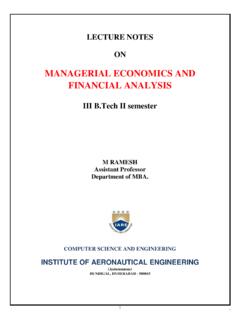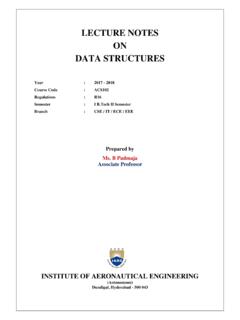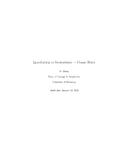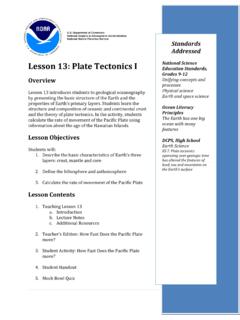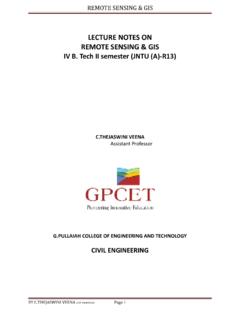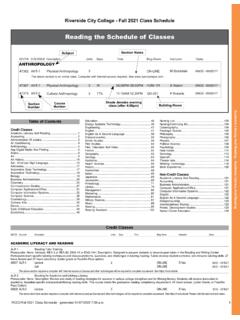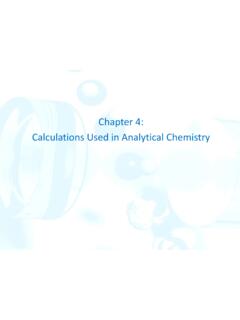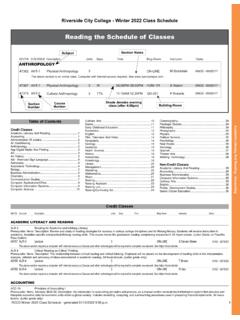Transcription of LECTURE NOTES ON STATISTICS FOR MANAGEMENT MBA I …
1 LECTURE NOTES ON STATISTICS FOR MANAGEMENT MBA I SEMESTER IARE-R18 Ms. G. Joseph Mary Assistant Professor MASTER OF BUSINESS ADMINISTRATION INSTITUTE OF AERONAUTICAL ENGINEERING (Autonomous) DUNDIGAL, HYDERABAD - 500 043 STATISTICS FOR MANAGEMENT I Semester: MBA Course Code Category Hours / Week Credits Maximum Marks CMBB05 Core L T P C CIA SEE Total 4 - - 4 30 70 100 Contact Classes: 45 Tutorial Classes: Nil Practical Classes: Nil Total Classes: 45 OBJECTIVES: The course should enable the students to: I. Understand the various statistical techniques and solve problems effectively in the STATISTICS . II. Analyze the different types of skewness and know about the coefficient variations of skewness. III. Know the application of statistical measures of central tendency and also statistical measures of dispersion.
2 IV. Emphasize application of ANOVA, other non-parametric test and analyze the recent trends. V. Apply the time series analysis and also trend analysis of data and also know its importance for solving the problems arising. COURSE OUTCOMES: 1. Recognize the significance, limitations, origin and development of STATISTICS . 2. Acquire the knowledge about different managerial applications of STATISTICS in various fields in modern times and analyze the use of computers in STATISTICS . 3. Discuss various types of measures of central tendency and measures of 4. Analyze the different types of coefficient of skewness and the coefficient of variation. 5. Understand the tabulation and classification of data to draw effective solutions for solving problems. 6. Demonstrate the diagrammatical and graphical representation of data by using different dimensional diagrams.
3 7. Examine the differences between uni-variate, bi variate and multi variate data. 8. Apply different types of small sample tests and techniques of ANOVA. 9. Analyze correlation analysis and different types of coefficient of correlation. 10. Describe the regression analysis, time series analysis and trend analysis of data. UNIT-I INTRODUCTION TO STATISTICS Classes:08 Overview, origin and development and managerial applications of STATISTICS and branches of the study, STATISTICS and computers, limitations of STATISTICS . UNIT -II MEASURES OF CENTRAL TENDENCY Classes:09 Mean, median, mode, geometric mean and harmonic mean, dispersion, range ,quartile deviation, mean deviation; co-efficient of variation skewness: Karl pearson co-efficient of skewness, bowleys co-efficient of skewness, kelleys co-efficient of skewness; theory and problems, discussion on direct and indirect methods of solving the problems.
4 UNIT -III TABULATION OF UNIVARIATE Classes:08 Bi variate and multi variate data, data classification and tabulation, diagrammatic and graphical representation of data. One dimensional, two dimensional and three dimensional diagrams and graphs. UNIT -IV SMALL SAMPLE TESTS Classes:10 T-Distribution: properties and applications, testing for one and two means, paired t-test; analysis of variance: one way and two way ANOVA(with and without interaction),chi-square distribution: test for a specified population variance, test for goodness of fit, test for independence of attributes; correlation analysis: scatter diagram, positive and negative correlation, limits for coefficient of correlation, Karl Pearson s coefficient of correlation, spearman s rank correlation, concept of multiple and partial correlation.
5 UNIT -V REGRESSION ANALYSIS Classes: 10 Concept, least square fit of a linear regression, two lines of regression, properties of regression coefficients; Time Series Analysis: Components, models of time series additive, multiplicative and mixed models; Trend analysis: Free hand curve, semi averages, moving averages, least square methods; Index numbers: introduction, characteristics and uses of index numbers, types of index numbers, un weighted price indices, weighted price indices, tests of adequacy and consumer price indexes. Text Books: 1. Levin , Rubin S. David, STATISTICS for MANAGEMENT , Pearson, 7th Edition, 2015. 2. Beri, Business STATISTICS , TMH, 1st Edition, 2015. 3. Gupta , Fundamentals of STATISTICS , HPH, 6th Edition, 2015. Reference Books: 1. Levine , Stephan , krehbiel , Berenson, STATISTICS for Managers using Microsoft Excel , PHI, 1st Edition, 2015.
6 2. J. K Sharma, Business STATISTICS , Pearson Publications, 2nd Edition, 2015. Web References: 1. 2. MANAGEMENT %20LT%20P%20C%203%201%200%204% E-Text Books: 1. 2. UNIT-I INTRODUCTION TO STATISTICS DEFINITION OF STATISTICS Branch of mathematics concerned with collection, classification, analysis, and interpretation of numerical facts, for drawing inferences on the basis of their quantifiable likelihood (probability). STATISTICS can interpret aggregates of data too large to be intelligible by ordinary observation because such data (unlike individual quantities) tend to behave in regular, predictable manner. It is subdivided into descriptive STATISTICS and inferential STATISTICS . HISTORY OF STATISTICS The Word STATISTICS have been derived from Latin word Status or the Italian word Statista , meaning of these words is Political State or a Government.
7 Shakespeare used a word Statist is his drama Hamlet (1602). In the past, the STATISTICS was used by rulers. The application of STATISTICS was very limited but rulers and kings needed information about lands, agriculture, commerce, population of their states to assess their military potential, their wealth, taxation and other aspects of government. Gottfried Achenwall used the word statistik at a German University in 1749 which means that political science of different countries. In 1771 W. Hooper (Englishman) used the word STATISTICS in his translation of Elements of Universal Erudition written by Baron Bieford, in his book STATISTICS has been defined as the science that teaches us what is the political arrangement of all the modern states of the known world.
8 There is a big gap between the old STATISTICS and the modern STATISTICS , but old STATISTICS also used as a part of the present STATISTICS . During the 18th century the English writer have used the word STATISTICS in their works, so STATISTICS has eveloped gradually during last few centuries. A lot of work has been done in the end of the nineteenth century. At the beginning of the 20th century, William S Gosset was developed the methods for decision making based on small set of data. During the 20th century several statistician are active in developing new methods, theories and application of STATISTICS . Now these days the availability of electronics computers is certainly a major factor in the modern development of STATISTICS . Descriptive STATISTICS and Inferential STATISTICS Every student of STATISTICS should know about the different branches of STATISTICS to correctly understand STATISTICS from a more holistic point of view.
9 Often, the kind of job or work one is involved in hides the other aspects of STATISTICS , but it is very important to know the overall idea behind statistical analysis to fully appreciate its importance and beauty. The two main branches of STATISTICS are descriptive STATISTICS and inferential STATISTICS . Both of these are employed in scientific analysis of data and both are equally important for the student of STATISTICS . Descriptive STATISTICS Descriptive STATISTICS deals with the presentation and collection of data. This is usually the first part of a statistical analysis. It is usually not as simple as it sounds, and the statistician needs to be aware of designing experiments, choosing the right focus group and avoid biases that are so easy to creep into the experiment.
10 Different areas of study require different kinds of analysis using descriptive STATISTICS . For example, a physicist studying turbulence in the laboratory needs the average quantities that vary over small intervals of time. The nature of this problem requires that physical quantities be averaged from a host of data collected through the experiment. MANAGERIAL APPLICATIONS OF STATISTICS STATISTICS is a the mathematical science involving the collection, analysis and interpretation of data. A number of specialties have evolved to apply statistical theory and methods to various disciplines. Certain topics have "statistical" in their name but relate to manipulations of probability distributions rather than to statistical analysis. Actuarial science is the discipline that applies mathematical and statistical methods to assess risk in the insurance and finance industries.
